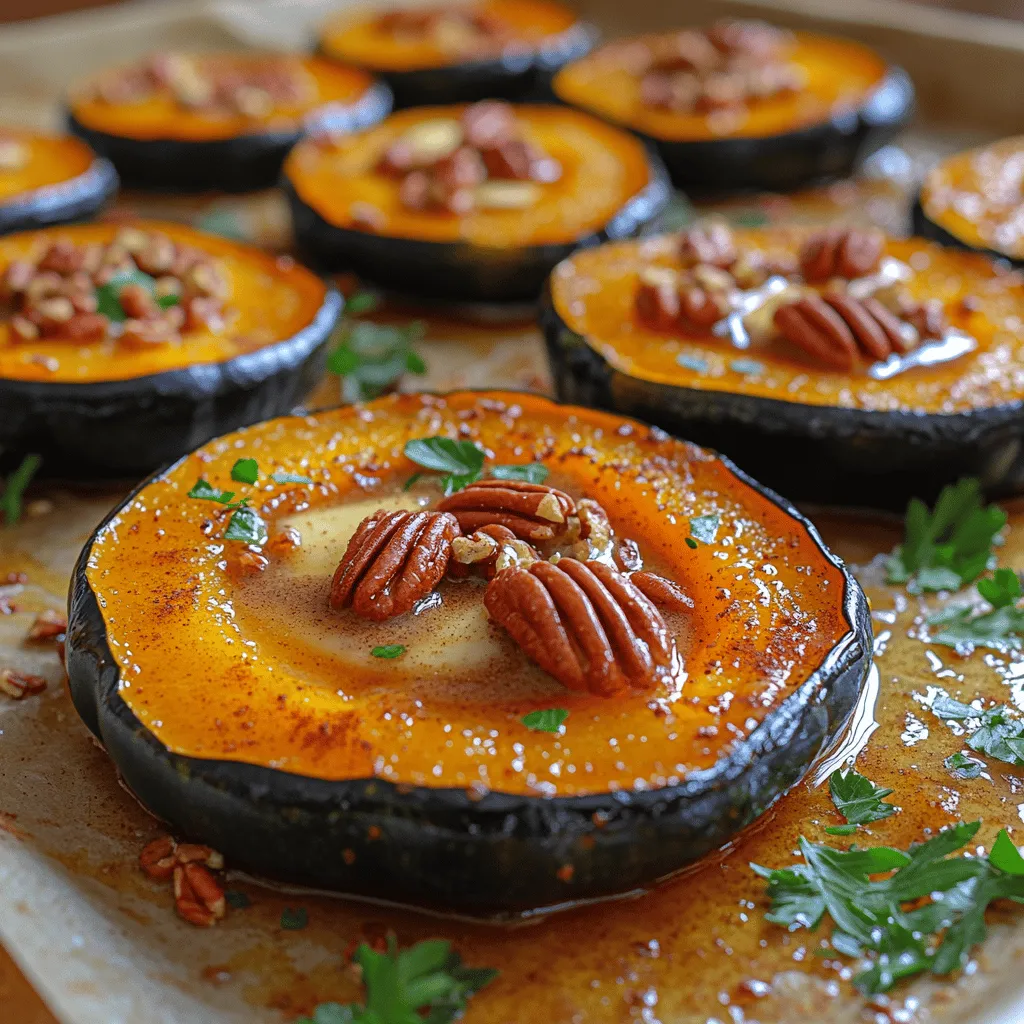Introduction
As the leaves turn golden and the air becomes crisp, kitchens across the country begin to fill with the warm, inviting scents of autumn. One dish that perfectly encapsulates the essence of this season is Roasted Acorn Squash with Maple Glaze. This delightful recipe not only highlights the rich flavors associated with fall but also celebrates the vibrant produce that defines this time of year. Acorn squash, with its sweet, nutty taste and unique shape, becomes a star ingredient in many autumnal dishes.
Incorporating acorn squash into your culinary repertoire is a wonderful way to enjoy its seasonal significance. This dish is not only delicious but also offers a variety of health benefits, making it an excellent choice for nutritious fall meals. Packed with vitamins A and C, fiber, and antioxidants, acorn squash is a versatile ingredient that lends itself well to both savory and sweet profiles. The addition of a maple glaze elevates the dish, adding a delectable sweetness that beautifully complements the squash’s natural flavors.
The Appeal of Autumn Ingredients
Autumn is a time of harvest, where the bounty of the season brings an array of produce that is both fresh and flavorful. From crisp apples to hearty root vegetables, the fall harvest encourages cooks to embrace local ingredients and celebrate the unique flavors they provide. Acorn squash is a prime example of this culinary shift, offering a delightful blend of sweetness and texture that is hard to resist.
The flavor profile of acorn squash is particularly appealing during the autumn months. Its subtle sweetness, combined with a slightly nutty taste, makes it an ideal canvas for both savory and sweet dishes. When roasted, it caramelizes beautifully, enhancing its natural sugars and creating a warm, inviting taste that perfectly complements the cooler weather. Pairing acorn squash with maple syrup not only enhances its inherent sweetness but also adds a rich, complex note that resonates with the seasonal theme.
Utilizing fresh, local ingredients is crucial in seasonal cooking. By sourcing your acorn squash from local farmers’ markets or grocery stores that prioritize local produce, you not only support your community but also ensure you are using the freshest ingredients possible. Fresh produce can significantly enhance the taste and nutritional value of your dishes, making them more satisfying and wholesome.
Understanding Acorn Squash
Acorn squash is a small, winter squash that is easily recognizable by its distinctive acorn-like shape and dark green or yellow-orange skin. The flesh inside is a bright orange hue, with a creamy texture that becomes tender and flavorful when cooked. Its taste is often described as a cross between pumpkin and sweet potato, making it a versatile ingredient for a variety of dishes.
Nutritionally, acorn squash is a powerhouse. It is low in calories yet high in essential vitamins and minerals, including vitamin A, which supports eye health, and vitamin C, which boosts the immune system. Additionally, acorn squash is an excellent source of dietary fiber, aiding in digestion and promoting a feeling of fullness. This makes it not only a delicious choice for autumn meals but also a healthy one.
When comparing acorn squash to other types of squash, such as butternut or spaghetti squash, it stands out for its unique flavor and texture. While butternut squash is known for its sweet, smooth flesh, acorn squash offers a slightly firmer texture and a more nutty flavor. Spaghetti squash, on the other hand, is primarily used for its fibrous strands, making it a popular low-carb alternative to pasta. Each type of squash has its own merits, but acorn squash’s versatility in both sweet and savory dishes makes it particularly appealing for fall recipes.
When selecting acorn squash, look for specimens that are heavy for their size with a dull, matte finish. Avoid squash that has soft spots or blemishes, as these can indicate spoilage. Proper storage is also essential; store uncut acorn squash in a cool, dry place for up to a month. Once cut, wrap the pieces tightly in plastic wrap and refrigerate, using them within a week for the best flavor and texture.
Ingredients Breakdown
Creating a delicious Roasted Acorn Squash with Maple Glaze requires a handful of simple yet flavorful ingredients. Each component plays a vital role in crafting the dish’s overall taste and texture. Let’s take a closer look at the key ingredients that make this recipe shine.
Acorn Squash
The star of this recipe is, of course, the acorn squash. Before cooking, you will need to prepare the squash by cutting it in half and removing the seeds. This can be done easily with a sharp knife and a spoon. Once halved, you can choose to slice it into wedges or leave it in halves for roasting, depending on your presentation preference. Roasting the squash brings out its natural sweetness and allows the flavors to develop beautifully.
Unsalted Butter
Butter is a fundamental ingredient in many cooking applications, and in this recipe, it plays a crucial role in enhancing flavor and promoting browning during roasting. Unsalted butter is preferred because it allows for better control of the overall saltiness of the dish. When melted and brushed over the squash, it creates a rich, golden glaze that adds depth to the flavor profile.
Maple Syrup
Maple syrup is the key ingredient that elevates this dish to new heights. The use of pure maple syrup, rather than imitation syrup, is essential for achieving an authentic flavor. Pure maple syrup provides a complex sweetness that complements the nutty notes of the squash beautifully. Additionally, it contains beneficial antioxidants and minerals, making it a healthier alternative to refined sugars. When drizzled over the roasted squash, it caramelizes, creating a glossy finish that enhances both appearance and taste.
Ground Spices
For an added warmth and aromatic quality, ground spices such as cinnamon and nutmeg are used in this recipe. These spices are synonymous with autumn cooking and contribute to the comfort and nostalgia associated with fall flavors. A sprinkle of cinnamon adds a hint of sweetness and warmth, while nutmeg introduces a slightly earthy tone that rounds out the dish. Together, they create a fragrant blend that enhances the overall sensory experience of the roasted squash.
Nuts
While optional, nuts such as pecans or walnuts can be added for extra texture and flavor. Toasted nuts provide a delightful crunch that contrasts with the tender squash, adding another layer of interest to each bite. If you choose to include nuts, be sure to chop them coarsely and sprinkle them over the top of the squash during the last few minutes of roasting to prevent burning.
By choosing high-quality ingredients and preparing them thoughtfully, you set the stage for a delicious and satisfying seasonal dish. Each component of the Roasted Acorn Squash with Maple Glaze works in harmony to create a dish that is not only visually appealing but also packed with flavor. As you embark on preparing this recipe, you’ll find that it effortlessly embodies the warmth and comfort of autumn cooking.


